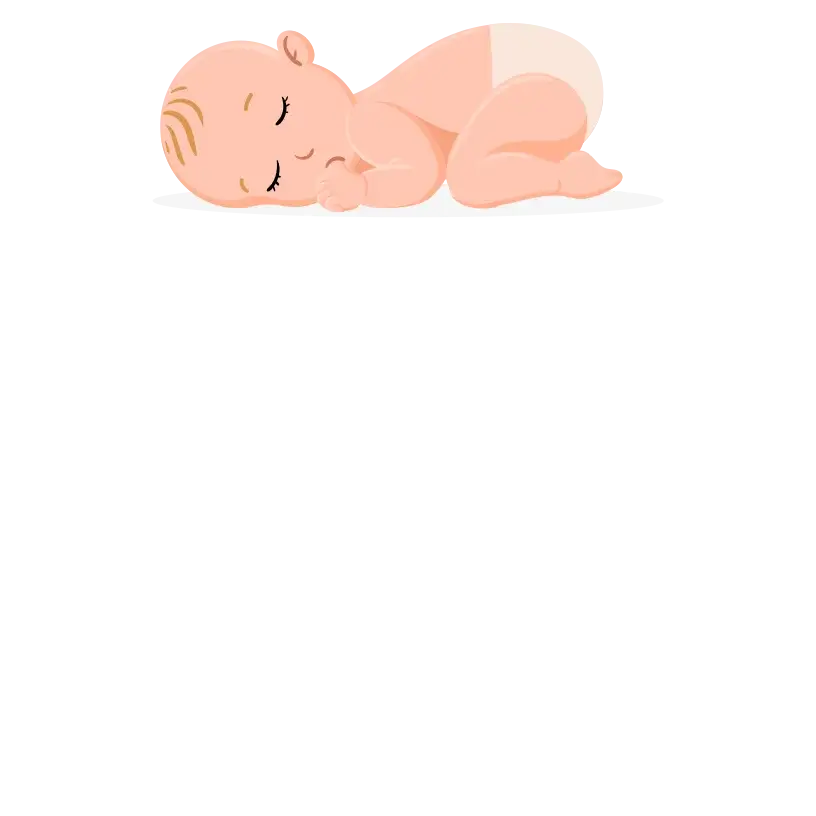Menu

You might notice you’re getting the hang of caring for your baby. You’re starting to understand their cues and adjusting to the parenting routine, even though it’s tiring. Your baby is becoming more awake and responsive, which is exciting, but it also means they might have more fussy moments, possibly indicating colic.
These periods of fussiness are normal as your baby adapts to the world around them, but it can be challenging. Remember, you’re not alone; asking for help is okay if needed.
In the first month, your newborn is expected to gain about 1 ounce (30 grams) of weight each day and grow in height by approximately 1 to 1½ inches (2.54 to 3.81 centimetres).
Your baby may experience rapid growth spurts around 7 to 10 days old and again at 3 and 6 weeks. These growth spurts are normal and indicate your baby is developing as expected.
Your baby’s growth and development are unique, so avoid comparing them to other babies. Your health visitor will monitor their progress and track their growth on centile charts. Your health visitor will provide guidance and support if there are any concerns.
According to the Centers for Disease Control and Prevention (CDC), exclusively breastfed babies usually gain weight faster for the first two months than formula-fed babies. However, breastfed infants tend to gain weight slower as they grow older than formula-fed babies throughout their first year. This variation in growth patterns is normal and reflects the different nutritional compositions of breast milk and formula.
Your baby’s feeding routine remains consistent at about 2 to 3 ounces of breastmilk or formula per feeding, totalling around 22 ounces daily. They’ll continue to feed every 2 to 3 hours, totalling 8 to 12 feedings in 24 hours. Formula-fed babies might be fed every three to four hours. It’s essential to follow their cues for hunger and ensure they’re getting enough nourishment throughout the day and night.
Monitoring wet diapers is a simple method to ensure your 3-week-old is adequately hydrated. Ideally, they should have at least six wet diapers daily, although more is acceptable. If your baby goes longer than eight hours without a wet diaper, it could indicate dehydration. Increase feeding frequency and seek guidance from your paediatrician if you’re uncertain about your baby’s hydration status.
Stick with breast milk or formula: Breast milk is packed with essential nutrients and antibodies that help protect your baby from illnesses. If breastfeeding isn’t possible, infant formula provides a close alternative. It’s crucial to avoid giving newborns water, juice, or other fluids, as their tiny stomachs can’t handle anything besides breast milk or formula.
Feed your newborn on cue: Pay attention to your baby’s hunger cues, like sucking on fists or lip-smacking, to feed them promptly. Waiting for later cues like fussing or crying can make feeding more challenging. When your baby shows signs of being full, such as closing their mouth or turning away from the bottle, they might need a break or a burp before continuing.
Keep feedings consistent: Consistency is key, especially if other family members or caretakers will be helping with feedings. Ensure everyone follows the same feeding routines and methods to ensure your baby’s comfort and well-being.
Expect variations in your newborn’s eating patterns: Your baby’s appetite can fluctuate, especially during growth spurts around two to three weeks after birth. It’s normal for them to eat more or want to be fed more frequently during these times. Instead of sticking strictly to a schedule, respond to your baby’s hunger cues to ensure they get enough nourishment.
Consider vitamin D supplements: Breast milk might not provide enough vitamin D, which is crucial for your baby’s bone development. Consult with your baby’s doctor about giving them vitamin D supplements, especially if you’re breastfeeding, to ensure they’re getting the nutrients they need for healthy growth and development.
At around 3 weeks old, your baby is still considered a newborn and will spend significant time sleeping. On average, they’ll sleep about 14 to 17 hours a day, often in stretches lasting three to four hours at a time. These long sleep periods are essential for your baby’s growth and development.
Between these sleep sessions, your baby will wake up to eat. Since their stomachs are small and they digest breast milk or formula quickly, they must feed frequently every two to three hours. This sleeping and eating pattern is normal for newborns and helps ensure they get the nourishment needed to thrive. As your baby grows, their sleep patterns will gradually change, but for now, enjoy those precious moments of cuddles with your little one.
Keep the room dark and use white noise to block out distracting sounds. This helps signal your baby that it’s time to sleep and can promote deeper, more restful sleep.
Encourage your baby to learn to fall asleep independently by putting them down in their crib or bassinet while awake. This teaches them to self-soothe and can prevent reliance on being rocked or held to sleep.
If your baby starts to fuss when you put them down, try soothing them with gentle techniques like singing a lullaby, patting their belly, or offering a pacifier. These comforting gestures can help your baby relax and settle into sleep more easily.
If your baby seems particularly fussy or resistant to sleep, it might be a sign that they need to rest sooner or more frequently. By responding to their cues and putting them to bed at the first signs of tiredness, you can help prevent them from becoming overtired and make it easier to fall asleep.
Remember, you can’t spoil a newborn by comforting and holding them. If your baby is crying and seems distressed, pick them up, rock them gently, and soothe them with shushing sounds or gentle pats. Once they’re calm, you can try putting them down to sleep again.
Keep the room dark and use white noise to block out distracting sounds. This helps signal your baby that it’s time to sleep and can promote deeper, more restful sleep.
Encourage your baby to learn to fall asleep independently by putting them down in their crib or bassinet while awake. This teaches them to self-soothe and can prevent reliance on being rocked or held to sleep.
If your baby starts to fuss when you put them down, try soothing them with gentle techniques like singing a lullaby, patting their belly, or offering a pacifier. These comforting gestures can help your baby relax and settle into sleep more easily.
If your baby seems particularly fussy or resistant to sleep, it might be a sign that they need to rest sooner or more frequently. By responding to their cues and putting them to bed at the first signs of tiredness, you can help prevent them from becoming overtired and make it easier to fall asleep.
Remember, you can’t spoil a newborn by comforting and holding them. If your baby is crying and seems distressed, pick them up, rock them gently, and soothe them with shushing sounds or gentle pats. Once they’re calm, you can try putting them down to sleep again.
Fever: Fevers can happen to most babies at some point, but it’s sometimes tricky to spot in newborns. During the first 12 weeks, if your baby feels warm or seems unusually fussy, it’s crucial to check their temperature using a rectal thermometer. If their temperature reads 100.4 degrees Fahrenheit or higher, seeking immediate medical attention is important. This ensures prompt evaluation and appropriate care if needed.
Colic: If your 3-week-old baby cries for more than three hours a day, lasting for over three weeks, they could have colic. This can be distressing, but it’s important to know that it’s relatively common, affecting one in five babies. The causes, ranging from gas to sensory sensitivities, aren’t entirely clear. It can be tough when you’re unable to soothe your baby, but the good news is that colic typically peaks by 5 to 6 weeks and usually resolves by 3 to 4 months.
Constipation: During the first month of life, pooping less than once a day might indicate your baby isn’t eating enough. However, if your three-week-old baby hasn’t had a bowel movement for some time, it’s a good idea to keep track of their wet diapers and bowel movements and discuss your concerns with your paediatrician.
Avoid giving your baby juice or other home remedies for constipation at this age without consulting your doctor first.
Cradle cap: If you’ve noticed scaly patches on your 3-week-old baby’s scalp, it’s likely cradle cap, a common condition in infants aged three weeks to 1 year. While it may look concerning, it usually clears up within that time frame.
The cradle cap doesn’t indicate allergies, eczema, or poor hygiene. You can simply wash your baby’s scalp with a mild shampoo to loosen the scales, and your paediatrician may prescribe a special shampoo if needed.
Clogged tear ducts: As your baby’s tear ducts develop, they might become blocked, leading to redness, excess tearing, or crustiness around the eyes. While this often resolves on its own, you can help by applying a warm, damp cloth to the affected eye to soothe any discomfort.
Your baby might start making sudden, jerky movements with their arms. This is a normal reflex action as their nervous system continues to develop.
Along with arm thrusts, your baby may exhibit strong reflex movements, such as kicking its legs or flailing its arms. These reflexes help your baby explore its environment and develop coordination.
Your baby’s hearing is becoming more acute at this stage. They may turn their heads towards familiar sounds or voices, indicating their growing awareness of their surroundings.
Your baby may start to prefer their mother’s breast milk over other forms of feeding. This recognition is a natural response as they become accustomed to the taste and smell of breast milk.
Your baby’s neck muscles are still developing, so their head may flop backwards when held upright or lifted. This is normal and will improve as their neck muscles strengthen over time.
Your baby’s hands may still be clenched into tight fists. This is a reflexive behaviour that gradually decreases as the nervous system matures.
Your baby might start making sudden, jerky movements with their arms. This is a normal reflex action as their nervous system continues to develop.
Along with arm thrusts, your baby may exhibit strong reflex movements, such as kicking its legs or flailing its arms. These reflexes help your baby explore its environment and develop coordination.
Your baby’s hearing is becoming more acute at this stage. They may turn their heads towards familiar sounds or voices, indicating their growing awareness of their surroundings.
Your baby may start to prefer their mother’s breast milk over other forms of feeding. This recognition is a natural response as they become accustomed to the taste and smell of breast milk.
Your baby’s neck muscles are still developing, so their head may flop backwards when held upright or lifted. This is normal and will improve as their neck muscles strengthen over time.
Your baby’s hands may still be clenched into tight fists. This is a reflexive behaviour that gradually decreases as the nervous system matures.
Diaper change: At this stage, your baby’s care routine primarily involves attending to their diaper changes, which can occur frequently throughout the day. It’s common to experience occasional diaper blowouts requiring extra attention and cleanup.
Circumcision: If your baby was circumcised at birth, keep an eye on the circumcision site to ensure it’s healing properly. Look out for signs of infection, like redness or swelling, and contact your doctor if you notice anything unusual.
For uncircumcised penises, there’s no need for special care. Simply wash your baby’s penis during bath time, like you would the rest of their body. It’s important not to try to pull down or force back the foreskin, as it will naturally retract on its own by around age.
Skincare: During week three, your baby may develop skin conditions like rashes, acne, or cradle cap, which are common but can cause discomfort. To help alleviate these issues, use a gentle soap specifically designed for sensitive skin, limit the number of baths your baby has to prevent further irritation, and avoid squeezing any spots, as this can lead to infection or worsening of the condition.
Bathing: Daily bathing for your baby isn’t necessary. If your baby is fussy and having trouble settling down for sleep, a warm bath can be soothing for both of you. Some babies may feel uncomfortable being undressed and exposed, so placing a warm, wet washcloth over their tummy during bath time can help them feel more secure and relaxed.
Remember to keep the water warm and comfortable, and always support your baby’s head and neck while bathing.

Interact with your baby by singing, talking, and reading to them using animated expressions. Pay attention to how they respond to different tones and facial cues. Research suggests that speaking to your newborn in a lively manner—using higher pitches, slower speech, and clear pronunciation—captures their attention and helps them understand language better.

Engage your 3-week-old with a soft, colourful toy like a sponge ball or stuffed animal. Hold it in front of their face and gently move it from side to side. Encourage your baby to follow the toy with their eyes. This activity helps develop their visual tracking and observation skills.

Spend time interacting with your baby by smiling, making funny faces, and sticking out your tongue. Get close to your baby so they can see your facial expressions. This helps them learn and understand emotions and encourages them to mimic your expressions.

Offering your baby massages isn’t just about providing comfort; it’s crucial for their overall health and emotional growth. Studies show that massaging babies can improve their sleep patterns, help them become more aware of their body, promote flexibility in their limbs, and lower stress hormone levels.

Place your baby on their tummy while they are awake and supervised. This position helps strengthen their neck, back, and shoulder muscles, which are essential for future milestones like rolling over and crawling. Start with short periods of tummy time and gradually increase as your baby becomes more comfortable.

Interact with your baby by singing, talking, and reading to them using animated expressions. Pay attention to how they respond to different tones and facial cues. Research suggests that speaking to your newborn in a lively manner—using higher pitches, slower speech, and clear pronunciation—captures their attention and helps them understand language better.

Engage your 3-week-old with a soft, colourful toy like a sponge ball or stuffed animal. Hold it in front of their face and gently move it from side to side. Encourage your baby to follow the toy with their eyes. This activity helps develop their visual tracking and observation skills.

Spend time interacting with your baby by smiling, making funny faces, and sticking out your tongue. Get close to your baby so they can see your facial expressions. This helps them learn and understand emotions and encourages them to mimic your expressions.

Offering your baby massages isn’t just about providing comfort; it’s crucial for their overall health and emotional growth. Studies show that massaging babies can improve their sleep patterns, help them become more aware of their body, promote flexibility in their limbs, and lower stress hormone levels.

Place your baby on their tummy while they are awake and supervised. This position helps strengthen their neck, back, and shoulder muscles, which are essential for future milestones like rolling over and crawling. Start with short periods of tummy time and gradually increase as your baby becomes more comfortable.

A pacifier can help soothe your baby when they’re fussy or need to suck for comfort. Make sure to choose one designed for newborns and the appropriate size for your baby’s age.

A baby swing can provide gentle motion that can help calm a fussy baby and even help them fall asleep. It’s useful when you need a break or your baby needs extra soothing.

Wearable blankets, also known as sleep sacks, are a safe alternative to traditional blankets for keeping your baby warm while they sleep. They eliminate the risk of loose blankets covering your baby’s face and reduce the risk of suffocation.

Diaper rash cream is essential for protecting your baby’s delicate skin from irritation and discomfort caused by diaper rash. Apply a thin layer to clean dry skin during diaper changes to help prevent and treat diaper rash.
A soft-bristled baby hair brush is gentle on your baby’s delicate scalp and can help manage the cradle cap by gently removing flakes and stimulating the scalp.
It’s important to use a brush designed for babies to avoid causing any discomfort or irritation to their sensitive skin. Regular brushing can also promote healthy hair growth and scalp circulation.

Ensure you have a safe and appropriate car seat for your newborn. You can opt for an infant car seat or a convertible car seat, depending on your preference and needs. Choosing a car seat that meets all current safety regulations and guidelines is essential to ensure your baby’s protection during travel.
Avoid purchasing a used car seat, as it may not meet current safety standards, and its history may be unknown, potentially compromising its effectiveness in an accident.

Wearing a baby carrier is a versatile and convenient way to keep your baby close while allowing you to move around hands-free. It provides a snug and secure environment for your little one, promoting bonding and comfort.
With your baby safely nestled against you, you can easily tend to daily tasks or simply enjoy some close cuddle time while keeping your hands free.

A pacifier can help soothe your baby when they’re fussy or need to suck for comfort. Make sure to choose one designed for newborns and the appropriate size for your baby’s age.

A baby swing can provide gentle motion that can help calm a fussy baby and even help them fall asleep. It’s useful when you need a break or your baby needs extra soothing.

Wearable blankets, also known as sleep sacks, are a safe alternative to traditional blankets for keeping your baby warm while they sleep. They eliminate the risk of loose blankets covering your baby’s face and reduce the risk of suffocation.

Diaper rash cream is essential for protecting your baby’s delicate skin from irritation and discomfort caused by diaper rash. Apply a thin layer to clean dry skin during diaper changes to help prevent and treat diaper rash.
A soft-bristled baby hair brush is gentle on your baby’s delicate scalp and can help manage the cradle cap by gently removing flakes and stimulating the scalp.
It’s important to use a brush designed for babies to avoid causing any discomfort or irritation to their sensitive skin. Regular brushing can also promote healthy hair growth and scalp circulation.

Ensure you have a safe and appropriate car seat for your newborn. You can opt for an infant car seat or a convertible car seat, depending on your preference and needs. Choosing a car seat that meets all current safety regulations and guidelines is essential to ensure your baby’s protection during travel.
Avoid purchasing a used car seat, as it may not meet current safety standards, and its history may be unknown, potentially compromising its effectiveness in an accident.

Wearing a baby carrier is a versatile and convenient way to keep your baby close while allowing you to move around hands-free. It provides a snug and secure environment for your little one, promoting bonding and comfort.
With your baby safely nestled against you, you can easily tend to daily tasks or simply enjoy some close cuddle time while keeping your hands free.
Once your 3-week-old baby has regained their birth weight and consistently gains weight at a healthy rate (about 1 ounce per day), it’s generally safe to allow them to sleep longer, particularly at night. You can gradually start letting them sleep longer during the night while keeping daytime naps shorter, around three hours or less.
However, if you notice your baby sleeping excessively and struggling to wake them up for feedings, or if they have difficulty staying awake during feedings, it’s important to consult their doctor for guidance and evaluation.
If you’re bottle-feeding your newborn, you can introduce a pacifier anytime. However, if you plan to breastfeed, you should wait until your baby is 3 to 4 weeks old after breastfeeding is established.
Babies naturally have a strong sucking reflex, and using a pacifier between feedings or during sleep can help soothe them and fulfil this need.
Your 3-week-old baby may be fussing and seeming constantly hungry for various reasons. One possibility is that they are going through a growth spurt, which can lead to increased appetite and fussiness. Babies also often go through periods of increased fussiness due to digestive discomfort, such as gas or colic.
Additionally, if you’re breastfeeding, your baby might be cluster feeding to stimulate milk production or seeking comfort. Ensuring your baby is properly latched and getting enough to eat is essential.
In the first few weeks, start with short tummy time sessions lasting 3-5 minutes a few times a day. As your baby gets more accustomed to it, gradually increase the duration to about 10-15 minutes several times throughout the day.
Remember the mantra “Back to sleep, tummy to play“ to encourage proper development and minimise the risk of flat spots on your baby’s head. Since babies spend much time sleeping on their backs, tummy time helps balance this by strengthening their neck, shoulder, and arm muscles.
It’s common for newborns to sleep often, sometimes up to 17 hours a day, especially during the first few weeks. However, if your 3-week-old is excessively sleepy to the point where it’s difficult to wake for feedings or does not feed well when awake, it’s worth discussing with your paediatrician to rule out any underlying issues. Otherwise, if they’re feeding well and gaining weight appropriately, it’s likely just a normal part of their development.
Once your 3-week-old baby has regained their birth weight and consistently gains weight at a healthy rate (about 1 ounce per day), it’s generally safe to allow them to sleep longer, particularly at night. You can gradually start letting them sleep longer during the night while keeping daytime naps shorter, around three hours or less.
However, if you notice your baby sleeping excessively and struggling to wake them up for feedings, or if they have difficulty staying awake during feedings, it’s important to consult their doctor for guidance and evaluation.
If you’re bottle-feeding your newborn, you can introduce a pacifier anytime. However, if you plan to breastfeed, you should wait until your baby is 3 to 4 weeks old after breastfeeding is established.
Babies naturally have a strong sucking reflex, and using a pacifier between feedings or during sleep can help soothe them and fulfil this need.
Your 3-week-old baby may be fussing and seeming constantly hungry for various reasons. One possibility is that they are going through a growth spurt, which can lead to increased appetite and fussiness. Babies also often go through periods of increased fussiness due to digestive discomfort, such as gas or colic.
Additionally, if you’re breastfeeding, your baby might be cluster feeding to stimulate milk production or seeking comfort. Ensuring your baby is properly latched and getting enough to eat is essential.
In the first few weeks, start with short tummy time sessions lasting 3-5 minutes a few times a day. As your baby gets more accustomed to it, gradually increase the duration to about 10-15 minutes several times throughout the day.
Remember the mantra “Back to sleep, tummy to play“ to encourage proper development and minimise the risk of flat spots on your baby’s head. Since babies spend much time sleeping on their backs, tummy time helps balance this by strengthening their neck, shoulder, and arm muscles.
It’s common for newborns to sleep often, sometimes up to 17 hours a day, especially during the first few weeks. However, if your 3-week-old is excessively sleepy to the point where it’s difficult to wake for feedings or does not feed well when awake, it’s worth discussing with your paediatrician to rule out any underlying issues. Otherwise, if they’re feeding well and gaining weight appropriately, it’s likely just a normal part of their development.
1. APP: Developmental Milestones: 1 Month
2. AAP: How often and how much should your baby eat?
3. Centres for Disease Control and Prevention: Breastfeeding as the Norm
4. Cleveland: Fever Symptoms & Causes
5. KidsHealth: Your Newborn’s Growth
6. Healthy Children: How Can I Tell If My Baby Is Constipated?
7. Healthy Children: The benefits of baby massage
8. Mayo Clinic: Feeding Your Newborn: Tips For New Parent
9. Stanford Children’s Health: Infant Sleep
10. Weisleder, A. and Fernald, A., 2013. Talking to children matters: Early language experience strengthens processing and builds vocabulary. Psychological science, 24(11), pp.2143-2152.
© Mindsmaking 2024